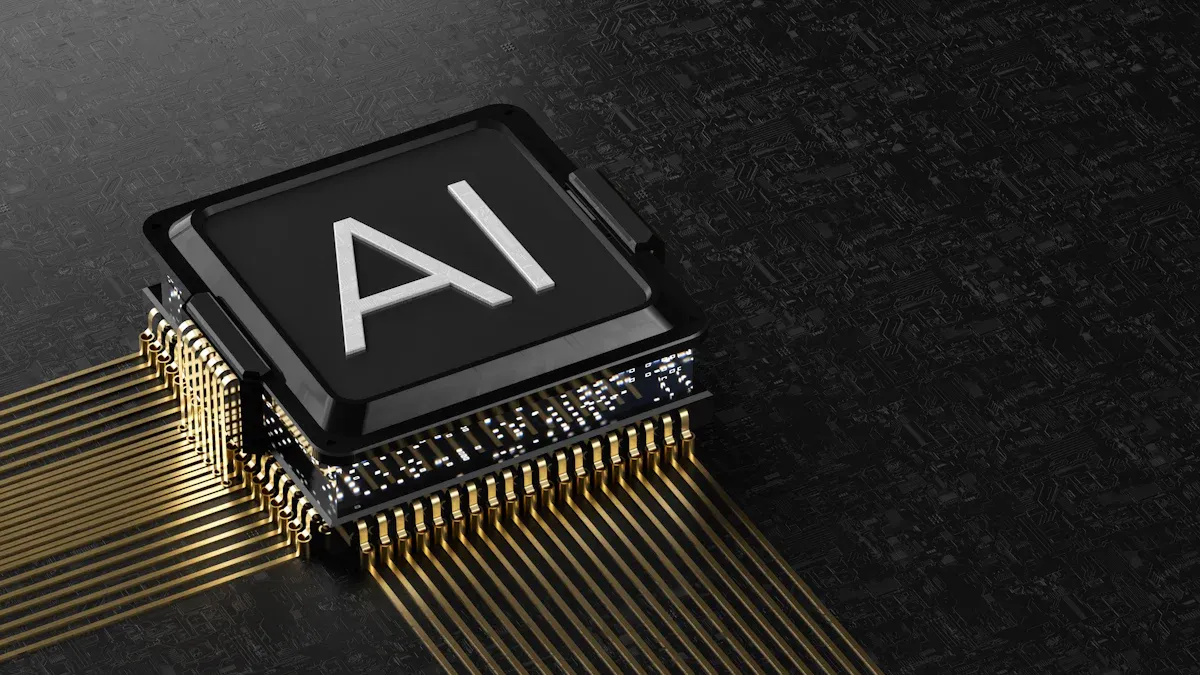How Semiconductors Are Steering the Future of Autonomous Driving

Semiconductors drive the intelligence and safety features in today’s autonomous vehicles. Modern cars use between 1,000 and 3,000 chips, with electric vehicles often containing more than 1,000 chips each. Texas Instruments leads innovation in automotive semiconductor integration, making vehicles smarter and safer. The automotive industry relies on semiconductors for advanced driving systems, connectivity, and real-time data processing. The table below shows the rapid growth in automotive semiconductor demand, highlighting how today’s semiconductors are powering the current and future landscape of autonomous driving.
Metric / Forecast | Numerical Evidence | Description |
|---|---|---|
Automotive semiconductor market size | Over $200 billion by 2030 | Market growth driven by autonomous driving and AI |
Fully autonomous cars by 2030 | Scale of autonomous vehicle deployment |
Key Takeaways
Semiconductors power the intelligence and safety features in autonomous vehicles by processing sensor data and enabling real-time decisions.
Advanced chips support driver assistance systems like collision avoidance, lane keeping, and emergency braking, making driving safer.
Electric vehicles rely heavily on semiconductors for efficient power management, battery control, and energy conversion.
AI acceleration and edge computing in semiconductors allow vehicles to process data quickly and operate safely without delays.
Ongoing innovation in semiconductor materials and supply chains is essential to meet growing demand and improve vehicle performance.
Semiconductors in Autonomous Driving

Intelligence and Sensing
Semiconductors form the backbone of intelligence in modern automotive systems. These tiny chips power the sensors, processors, and communication modules that allow vehicles to understand and interact with their environment. Automotive manufacturers rely on semiconductors to enable advanced driver assistance systems, or ADAS, which help vehicles detect obstacles, recognize road signs, and maintain safe distances from other cars.
Texas Instruments leads the industry by providing radar sensors and embedded processors that serve as the eyes and brains of intelligent vehicles. These semiconductor solutions work with sensor modules such as radar, lidar, and cameras. Each module collects different types of data, giving vehicles a complete view of their surroundings. For example, radar sensors measure distance and speed, while cameras identify objects and lane markings. Lidar adds another layer by mapping the environment in three dimensions.
The integration of these sensor modules depends on high-speed data transfer. Technologies like FPD-Link™ SerDes from Texas Instruments allow uncompressed video and control data to move quickly between sensors and central processors. This rapid communication ensures that vehicles can process information in real time, which is essential for safe and reliable driving.
The 'Connected Car Market Size, Share & Analysis' report confirms that semiconductors are the foundation of vehicle intelligence and connectivity. The report highlights the growing market for electronic control units, telematics, and sensors, all powered by advanced semiconductor technology.
Automotive chips with enhanced processing power support complex algorithms and real-time sensor data analysis. AI and neural processing units embedded in these chips enable vehicles to make quick decisions, such as when to brake or steer. Companies like Tesla and NVIDIA have demonstrated the importance of high-performance semiconductor chips in their autonomous driving platforms. Tesla’s Full Self-Driving computer and NVIDIA’s DRIVE platform both use advanced processors to handle massive amounts of sensor data and support features like adaptive cruise control and lane keeping.
Key roles of semiconductors in intelligence and sensing:
Enable real-time environment sensing and prediction
Support AI-driven decision-making for ADAS
Facilitate high-speed communication between sensors and processors
Power advanced features like collision avoidance and emergency braking
Autonomous vehicles use more chips than traditional cars, with each vehicle containing up to 20 sensor chips. These chips support technologies such as vehicle-to-everything (V2X) communication and ultra-wideband localization, making vehicles smarter and more responsive to their environment. Collaboration between automotive manufacturers and semiconductor companies continues to drive innovation, improving both intelligence and safety.
Safety and Compliance
Safety stands at the center of automotive design, especially as vehicles become more autonomous. Semiconductors play a critical role in meeting strict safety and regulatory standards. Automotive-qualified chips from companies like Texas Instruments are designed and tested to comply with international safety regulations, including ISO 26262, FMVSS, and Euro NCAP.
Regulatory standards and methodologies:
ISO 26262: Sets functional safety requirements for electrical and electronic systems in vehicles.
Automotive Safety Integrity Level (ASIL): Classifies risk and guides reliability requirements for semiconductor components.
SN29500 and IEC 62308: Predict and calculate failure rates of automotive electronics.
FMVSS: Establishes mandatory safety performance requirements in the United States.
Euro NCAP: Provides independent safety ratings for vehicles, focusing on ADAS and autonomous technologies.
Automotive engineers use advanced methodologies such as Failure Modes and Effects Analysis (FMEA), fault-tolerant designs, and redundancy strategies to ensure that semiconductor-powered systems remain reliable. These practices help vehicles maintain critical functions, even if one component fails. For example, backup chips can take over if a primary processor encounters a problem, keeping safety features like emergency braking and stability control active.
Proactive real-time system health monitoring, enabled by semiconductor technology, allows vehicles to detect and address irregularities before they impact safety. This continuous monitoring supports compliance with evolving regulations and enhances overall vehicle dependability.
Emerging technologies, including AI and machine learning, now assist in predictive failure analysis. Cloud-based platforms provide centralized, real-time monitoring of semiconductor health, further improving safety. These advancements help automotive manufacturers meet the demands of harsh environments, complex integration, and strict industry standards.
Semiconductors not only power the intelligence behind ADAS but also ensure that vehicles meet the highest levels of safety and compliance. As the automotive industry moves toward greater autonomy, the role of semiconductor technology in protecting drivers, passengers, and pedestrians will only grow.
ADAS and Semiconductor Innovation

Data Processing
Automotive manufacturers rely on semiconductors to power advanced driver-assistance systems. These systems use chips to process huge amounts of data from sensors in real time. The automotive semiconductor market reached $43.26 billion in 2022 and continues to grow as more vehicles use ADAS features. Semiconductors enable functions like automatic emergency braking and adaptive cruise control by quickly analyzing sensor data and making split-second decisions.
Modern vehicles need high processing power to handle complex algorithms and large data streams. Semiconductor chips deliver this power, supporting real-time object detection and hazard prediction. Edge computing, made possible by advanced chips, reduces latency and allows vehicles to react instantly to changing road conditions. This capability is critical for autonomous driving, where every millisecond counts.
Automotive companies like Texas Instruments lead the way with innovations in chip technology. Their processors and high-speed video transfer solutions help vehicles process information from multiple sources at once. These chips also support AI and machine learning, which improve object recognition and navigation. As a result, ADAS features become more accurate and reliable, making driving safer for everyone.
Research shows that semiconductors are essential for ADAS performance. Forward Collision Prevention, powered by advanced driver-assistance systems, can reduce crash rates by 29%. Lane Keeping Assistance lowers crash rates by 19%, and Blind Zone Detection by 9%. These improvements highlight the direct link between semiconductor advancements and vehicle safety.
Sensor Fusion
Sensor fusion combines data from different sensors—such as radar, lidar, cameras, and ultrasonic sensors—to create a complete picture of the vehicle’s surroundings. Semiconductors play a key role in this process. They integrate and process information from each sensor, allowing advanced driver assistance systems to make better decisions.
Engineering studies and industry conferences, including those from IEEE, show that sensor fusion technologies depend on powerful semiconductor components. These chips handle image processing, sensor integration, and real-time analysis. By merging data from multiple sources, vehicles can detect objects more accurately and respond to hazards faster.
Automotive manufacturers use modular compute architectures, such as centralized and domain-based systems, to optimize data processing. These architectures rely on semiconductors for flexibility and scalability. Enhanced connectivity, including 5G and Vehicle-to-Everything (V2X) communication, further improves sensor fusion by enabling real-time data exchange between vehicles and infrastructure.
The table below shows projected revenue growth for key semiconductor categories supporting ADAS:
Semiconductor Category | Projected Revenue by 2027 (USD) | Key Trend |
|---|---|---|
Logic Chips | Over $8 billion | Growth driven by HPC chips for ADAS and autonomous driving |
Memory Chips | Over $7 billion | Increased storage for source code, map data, and real-time processing |
Microprocessors | Over $15 billion | More computing power for complex algorithms and automotive-specific MCUs/MPUs |
Analog Chips | Over $17 billion | Enhanced accuracy, reduced noise, faster response |
Optoelectronic Devices | Over $8 billion | High performance, precision, integration, cost-effectiveness |
Discrete Devices | Over $11 billion | Efficiency, power density, miniaturization, use of SiC and GaN materials |
Sensors | Over $9 billion | Integration and intelligence for data gathering and processing |
This growth reflects the rising demand for advanced driver-assistance systems and the importance of semiconductors in sensor fusion.
Real-World Applications
Semiconductors power a wide range of real-world ADAS applications in today’s vehicles. Automotive companies use chips to enable features such as parking assist, lane keeping, collision monitoring, and automatic emergency braking. These features rely on data from multiple sensors, processed by high-performance chips, to keep drivers and passengers safe.
Several leading companies demonstrate the impact of semiconductor innovation in ADAS. Tesla’s Full Self-Driving chip, NVIDIA’s DRIVE platform, and Intel’s EyeQ series all use advanced chips for neural network processing, sensor fusion, and real-time decision-making. Qualcomm’s Snapdragon Ride and V2X communication chips enable vehicles to communicate with each other and with infrastructure, supporting safer and more efficient driving.
Automotive manufacturers also use LIDAR sensors for 3D mapping, RADAR for object detection in poor weather, and cameras for pedestrian and traffic sign recognition. Ultrasonic sensors help with parking and low-speed maneuvers. By integrating these technologies, vehicles can perform complex tasks like autonomous emergency braking, lane change assistance, and traffic jam aid.
Key ADAS applications powered by semiconductors:
Adaptive cruise control
Lane keeping assistance
Blind spot detection
Parking assist
Autonomous emergency braking
The demand for advanced driver-assistance systems continues to rise. Market projections show that the automotive semiconductor market could reach $91 billion by 2030, driven by consumer demand for safety and convenience. Robotaxis and fully autonomous vehicles will depend even more on semiconductor innovation, as they require even greater intelligence and reliability.
The ongoing advancements in semiconductors, sensor technology, and AI are moving the automotive industry closer to fully autonomous driving. As robotaxis and other autonomous vehicles become more common, the role of advanced driver-assistance systems and semiconductor innovation will only grow.
Powertrains and In-Cabin Features

Electric Power Management
Semiconductors play a vital role in the powertrains of electric vehicles. They manage energy flow, control battery systems, and improve thermal performance. Automotive manufacturers use advanced semiconductor devices to support efficient power conversion and energy management in EVs. These chips help control traction motors, battery charging, and regenerative braking systems.
Powertrain applications dominate semiconductor use in EVs, with market value expected to grow from $5.5 billion in 2024 to $24.0 billion by 2035.
Wide-bandgap materials like silicon carbide (SiC) and gallium nitride (GaN) improve energy efficiency and thermal handling, making electric vehicles more reliable.
Government incentives and emission regulations drive demand for semiconductor solutions that boost vehicle performance.
Power semiconductors, analog and digital chips, MEMS sensors, and microcontrollers support functions such as energy conversion, control, and safety.
The overall semiconductor market for electric vehicles is projected to reach $50 billion by 2035, reflecting their growing importance in automotive powertrains.
Automotive companies invest in these technologies to meet strict efficiency and safety standards. Traction motor applications hold a significant market share, showing how essential semiconductors are for electric powertrain operation. Asia-Pacific leads the market, with China advancing semiconductor technologies for EVs.
User Experience
Inside the cabin, semiconductors transform the driving experience. Automotive designers use these chips to power infotainment systems, digital cockpits, and driver monitoring features. The next-generation digital cockpit market is set to grow from $25.6 billion in 2023 to $61.4 billion by 2032. This growth comes from rising consumer demand for enhanced connectivity, safety, and entertainment in electric vehicles.
Semiconductor innovations enable advanced features such as augmented reality navigation, voice assistance, and seamless 5G connectivity. Companies like Qualcomm and NVIDIA lead the market with solutions for digital cockpits and infotainment. Qualcomm’s Snapdragon Digital Chassis and NVIDIA’s DRIVE platform support connectivity, AI, and display technologies in both passenger and commercial vehicles.
Qualcomm offers a broad portfolio for connectivity, infotainment, and ADAS, serving over 50 customers for digital cockpit solutions.
NVIDIA focuses on cockpit and autonomous driving chips, with its Orin chip used in models like Polestar 3 and Volvo EX90.
Both companies show strong market traction, highlighting the critical role of semiconductors in advancing in-cabin features.
Automotive manufacturers rely on these technologies to deliver a safer, smarter, and more enjoyable experience for drivers and passengers in electric vehicles.
High-Performance Computing for Autonomous Driving
AI Acceleration
AI acceleration stands at the heart of how today’s semiconductors are powering the current and future landscape of autonomous driving. Modern vehicles use specialized chips, such as neural processing units (NPUs) and graphics processing units (GPUs), to handle complex AI workloads. These chips process data from sensors, cameras, and radar in real time, enabling vehicles to recognize objects, predict movements, and make safe driving decisions. Companies like Tesla and NVIDIA have developed custom semiconductor solutions, such as the Full Self-Driving chip and the DRIVE platform, to support advanced autonomous features.
The demand for high-performance semiconductor technology continues to grow. The market for AI and deep learning chips reached about $40 billion in 2020 and is projected to hit $70 billion by 2025. This growth comes from the increasing use of ADAS, EVs, and autonomous vehicles. Key industry players include Intel, Qualcomm, and NXP Semiconductors, all investing heavily in research and development. The table below highlights important aspects of semiconductor-driven AI acceleration:
Aspect | Details |
|---|---|
AI and Deep Learning Chips | NPUs, GPUs, custom ASICs for real-time AI tasks |
Market Size & Growth | $40B (2020) to $70B (2025), ~10% CAGR |
Key Industry Players | Intel, Nvidia, Qualcomm, NXP, Infineon |
Case Studies | Tesla FSD chip, Nvidia DRIVE platform |
Emerging Technologies | 5G, quantum computing, advanced sensors |
These advancements show how today’s semiconductors are powering the current and future landscape of autonomous driving by enabling faster, smarter, and safer vehicle systems.
Edge Computing
Edge computing transforms how today’s semiconductors are powering the current and future landscape of autonomous driving. Instead of sending all data to the cloud, vehicles process information locally using powerful chips. This approach reduces latency, allowing vehicles to make split-second decisions. Edge AI systems use optimized semiconductor hardware to analyze sensor data, support real-time inference, and improve operational efficiency.
Key benefits of edge computing in autonomous vehicles include:
Real-time decision-making without cloud delays
Lower bandwidth and power consumption
Enhanced security and privacy through local data processing
Continuous operation, even without internet connectivity
On-device learning for self-improving systems
Major semiconductor companies, such as Intel, TSMC, Samsung, and NVIDIA, develop edge AI chips that support these capabilities. By 2030, most autonomous systems, including EVs, will rely on edge AI for immediate responses and operational resilience. The evolution of agentic AI and multi-agent systems will further enhance how today’s semiconductors are powering the current and future landscape of autonomous driving, making vehicles more adaptable and intelligent.
Market trends reinforce this shift:
China targets 50% of new cars sold as Level 2 or higher autonomous vehicles by 2025.
Tesla’s Full Self-Driving Beta adoption grew by 400% in 2023.
The self-driving truck market could reach $88 billion by 2035.
The autonomous driving software platform market is set to grow from $4.5 billion in 2024 to $30 billion by 2033.
These trends highlight the critical role of semiconductors and chips in supporting the rapid adoption of autonomous features in EVs and other vehicles. As technology advances, how today’s semiconductors are powering the current and future landscape of autonomous driving will continue to shape the automotive industry.
Challenges and Future Trends
Supply Chain
The semiconductor industry faces major supply chain challenges as automotive semiconductor demand continues to rise. In 2021 and 2022, a global shortage of semiconductors led to production losses of over 10 million vehicles. This event exposed how a few key players control more than 60% of the market, creating risks for automakers. China now accounts for over 40% of global EV semiconductor demand, showing how regional trends shape the industry. The supply chain for semiconductors is complex, with automakers depending on several tiers of suppliers. Many Tier 3 foundries focus on other markets, which can delay automotive chip production. The Just in Time sourcing model adds more risk, as seen during the pandemic when suppliers prioritized other sectors. Experts recommend closer collaboration, better monitoring, and new sourcing strategies to build a more resilient supply chain for the future.
Advanced Materials
Advanced materials drive new trends in the semiconductor industry, especially for EVs and next-generation vehicles. Reports highlight the adoption of wide-bandgap materials like gallium nitride and silicon carbide. These materials improve power efficiency and thermal management in automotive applications. Companies such as Infineon and Wolfspeed develop silicon carbide technologies that reduce energy loss and boost system efficiency. The demand for miniaturization and high-performance computing pushes the industry to use new materials for better transistor performance and lower power consumption. As electric vehicles and robotaxis become more common, the need for advanced materials in semiconductors will only grow. These innovations in chip technology support the automotive revolution and help meet strict energy and safety standards.
Industry Impact
Semiconductors shape the future of the automotive industry by enabling new applications and driving transformation. The sector grew from $40 billion in 2020 to a projected $70 billion by 2025, fueled by trends in autonomous driving and EVs. Regulatory mandates, such as those in the EU, require features like automatic emergency braking and lane departure warnings, increasing automotive semiconductor demand. Companies invest in new technologies, including AI chips, microcontrollers, and power semiconductors, to support safety, connectivity, and energy management. Consumer demand for convenience and safety also drives adoption of ADAS and infotainment systems. As 5G and quantum computing emerge, the semiconductor industry will continue to lead the automotive revolution, shaping the future of next-generation vehicles and their applications.
Semiconductors shape the future of autonomous driving by powering intelligence, safety, and user experience. Companies like Texas Instruments lead with ongoing innovation. The industry advances through:
Rapid development in chip technology and materials
AI-optimized chip structures for faster processing
Advanced packaging for improved reliability
These breakthroughs help vehicles become safer and smarter. As semiconductor technology evolves, the automotive landscape will continue to transform, offering new possibilities for drivers and passengers.
FAQ
What role do semiconductors play in autonomous vehicles?
Semiconductors act as the core components in autonomous vehicles. They process sensor data, enable real-time decision-making, and support safety features. These chips help vehicles detect obstacles, manage power, and communicate with other systems.
How do semiconductors improve vehicle safety?
Automotive semiconductors support advanced driver assistance systems. They monitor vehicle health, enable emergency braking, and help maintain lane position. Manufacturers use these chips to meet strict safety standards and reduce the risk of accidents.
Why do electric vehicles need more semiconductors?
Electric vehicles use more semiconductors because they require advanced power management, battery monitoring, and thermal control. These chips help manage energy flow, support fast charging, and ensure efficient operation of electric motors.
Which companies lead in automotive semiconductor innovation?
Texas Instruments, NVIDIA, Qualcomm, and Infineon lead in automotive semiconductor technology. They develop chips for radar, AI processing, and connectivity. Their innovations drive the evolution of autonomous and electric vehicles.
What trends shape the future of automotive semiconductors?
The industry moves toward AI acceleration, edge computing, and advanced materials like silicon carbide. These trends support smarter, safer, and more energy-efficient vehicles. Market growth and new regulations also drive rapid innovation in semiconductor technology.
See Also
Unveiling The Main Automotive Capabilities Of FREESCALE MCF5251CVM140
Ways Keep Booming Technology Sustains Superior Electronics Quality
A Deep Dive Into MC9S12DJ256MFUE Specs For Vehicles
CALL US DIRECTLY
(+86)755-82724686
RM2508,BlockA,JiaheHuaqiangBuilding,ShenNanMiddleRd,Futian District,Shenzhen,518031,CN
www.keepboomingtech.com sales@keepboomingtech.com
